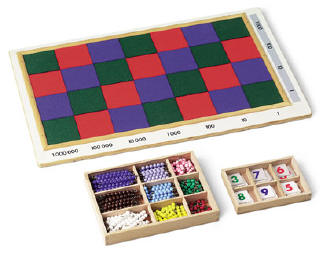Checkerboard: Introduction
Contents
Age
6-9.
Materials
- Box of bead bars, 55 of each (remove the 10-bars)
- Box containing numeral cards 1-9
- 3 series printed in black on white cards (multiplicand)
- 3 series printed in black on gray cards (multiplier)
- The Checkerboard:
- each square has sides of 7 cm so that the longest bar will fit;
- squares of the same color on the diagonal represent the same value;
The numbers along the side and the bottom are printed in hierarchic colors the bottom right square, which is green and represents simple units is the square having the least value; whereas the square in the opposite corner, which is also green and represents units of billions, is the square having the greatest value also.
Preparation
Familiarize the children with the board, noting the value of each square, the hierarchic colors, and the pattern of the values along the diagonal. Afterward the child may draw his own board.
Presentation
- Directress places a bead bar such as (5) on the unit square and asks the child to identify its value.
- Move the bead bar to the left to the tens square.
- Identify its value. (50)
- Move the bead bar along the diagonal to the next tens square.
- Identify its value. (50)
- Place the bead bar on the bottom row-hundred square.
- Continue moving the bead bar, and identifying its value as it changes its position.
- Place a bead bar on the unit square and identify its value.
- As it moves up the column, identify its value. Note that the value increases by 10 each time.
- Repeat the procedure moving the bead bar down the column, noting that the value decreases by 10 each time.
- Move the bead bar to the ten square at the bottom and repeat the game.
- Again we notice that the value increases by 10 as it goes toward the top, and it decreases by 10 as it moves toward the bottom again.
- Place two bead bars on two different squares and read its value.
- Place two bead bars in such a way that an inferior hierarchy is left blank.-430,403.
- Place four bead bars on four different squares along the bottom row.
- Identify the number.
- Move one bar to the second row and identify the value; it is the same.
- Continue moving one bead bar at a time along the diagonal, identifying the number; it stays the same.
Control Of Error
Points Of Interest
With the bead frames and the hierarchic materials (blocks) we gave the concept of the hierarchies. With this material we will reinforce that concept. Since the concept is presented in a different way, we must be sure that the child understands how this work is organized.
Purpose
- To familiarize the child with the board.
- To emphasize that squares on the diagonal have the same value.
Variation
Links

